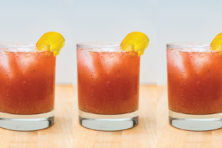Rediscovering Vermouth
- Share
- Tweet
- Pin
- Share

If you’re a cocktail drinker who has never given much more than a passing thought to vermouth, you have a lot of company.
“Americans generally treat vermouth as something that is supposed to be in the drink, but that they don’t want to taste in the drink,” said Kendall Johnson, bar manager at Waterfront Restaurant, as she and Zach Lozoff, longtime-bartender-turned-cocktail-ambassador, gave me a tutorial on the long-buried ingredient that has slowly made its way to the front of any good bar’s shelf.
Most of us know vermouth in two ways: as the dry version we’re supposed to rinse our martini glass with, or as the sweet version our grandparents put in their Manhattans. Over the years, proportions of vermouth in cocktails such as martinis and Manhattans have been dramatically reduced. Where once a cocktail would be made with a third part vermouth, it’s now a splash or a rinse.
But as cocktail culture has made its comeback over the past decade, so has our understanding of vermouth.
Vermouth is an aromatized, fortified wine, flavored with botanicals such as roots, bark, flowers, herbs and spices. The European Union has strict rules for products that carry the vermouth name: They must be 14.5% to 22% alcohol by volume (ABV); they must be 75% wine; and they must include wormwood as a bittering agent, among other rules.
Vermouth has long been popular in Europe, where many drink it straight or on the rocks with a twist of lemon. If that sounds disgusting to you, then your vermouth palate is probably similar to what mine was not long ago: Martini & Rossi sweet or dry, likely out of a rarely touched, dusty bottle.
A couple years ago, Lozoff introduced me to better vermouth, and it expanded my cocktail horizons. A high-quality vermouth will run you about three times the cost of Martini & Rossi, but it’s worth it not only for making a better Manhattan or martini, but also for creating easy-sipping, simple, low-alcohol drinks that are perfect for a warm spring afternoon, like the Spanish Gin and Tonic or just a glass of vermouth with a lemon twist.
Grab a bottle to see for yourself!
Martini

• 2 oz gin (Letherbee Autumnal)
• 1 oz dry vermouth (Dolin)
Add all ingredients to a mixing glass with ice and stir until well chilled. Serve up in a chilled coupe or martini glass.
Though simple, this recipe will produce a martini that will taste like an entirely different cocktail to most drinkers. Most make a martini with no more than a rinse of vermouth in the glass, but using the full portion in a 2:1 ratio produces an herbaceous, floral cocktail.
Boulevardier

• 1½ oz whiskey (New Riff)
• 1 oz sweet vermouth (Cocchi Torino)
• 1 oz Campari
• Twist of orange peel for garnish
Add all ingredients to a mixing glass with ice and stir until well chilled. Serve over a big cube.
A Boulevardier is similar to a Negroni, but replaces gin with whiskey. In this version, we change the proportions as well, adding extra whiskey to bring the flavor to the forefront.
Negroni

• 1 oz gin
• 1 oz Campari
• 1 oz sweet vermouth (Cocchi Torino)
Add all ingredients to a mixing glass with ice and stir until well chilled. Serve over a big cube or up in a chilled coupe glass. For a sweeter flavor, substitute Rinomato – what Lozoff calls the “Dreamsicle bitter” – for Campari.
Spanish Gin and Tonic

• 1½ oz gin (Gin Mare)
• 1 oz dry vermouth (Carpano Bianco or Yzaguirre)
• Tonic to fill the glass
• Citrus round for garnish
Fill a glass with ice, add the gin and vermouth, and fill with tonic. Add a citrus round as a garnish.
Make yourself a better gin and tonic by adding a quality dry vermouth that will sweeten the drink slightly and add complexity of flavor. It’s a simple build for impressive results, or what Lozoff called “soda for adults.”
Martinez

• 1½ oz gin
• 1 oz vermouth
• 1 cocktail spoon Maraschino liqueur
• 2 dashes orange bitters
• Lemon twist for garnish
Add all ingredients to a mixing glass with ice and stir until well chilled. Serve up in a chilled coupe or martini glass.
Don’t get the Maraschino liqueur confused with the juice from a jar of maraschino cherries. I’ve done it, tried it in a drink, and although I’m not so picky that I didn’t drink it, it definitely isn’t the same thing.
Manhattan

• 2 oz rye whiskey (Rittenhouse)
• 1 oz vermouth (Carpano Antica)
• Dash Angostura orange bitters
• Dash Angostura bitters
Put all ingredients in a mixing glass with ice and stir until well chilled. Serve over a big cube, or up in a chilled coupe or martini glass.
This is the classic proportion, but Lozoff and Johnson said they typically double the whiskey. “The modern drinker wants the flavor of the bourbon or whiskey to be at the forefront,” Johnson said.




